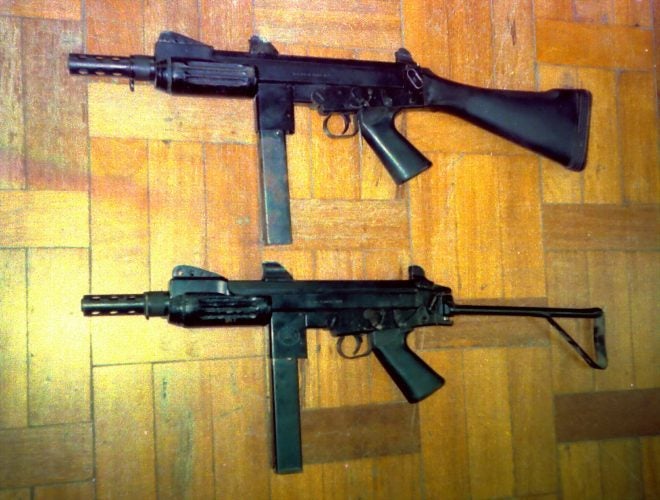As a long-time (since the mid-1960s) licensed manufacturer of the well-known 7.62x51mm FN FAL rifle for the Brazilian Armed and Police Forces, plus also for export, IMBEL – Indústria de Material Bélico do Brasil took the opportunity to use it as a basis for other firearms. How this eventually took the form of several 5.56x45mm rifle variations, from the MD1 prototype of 1983 to the MD97 models of the late 1990s, has recently been shown by TFB in a series of articles. But it is not generally known that the weapon was also used as a basis for a number of 9x19mm submachine gun and carbine projects that originated from the Fábrica de Itajubá (Itajubá Factory) facilities’ Oficina de Protótipos (Prototypes Workshop). The idea was, of course, using off-the-shelf FAL parts (unchanged and/or slightly modified) in their subgun designs so that development time could be abbreviated and production costs, pretty much reduced. Here’s a brief account of the SMGs that were built and tested by IMBEL in the late-1970s/early-1980s period.
The first physical result received the in-house designation M979 based on the year a first prototype was completed, but it was generally referred to as the “Falzinho”, or Little Fal. Its more obvious external relation to the rifle could be noticed in the use of the same synthetic pistol grip and trigger components, and a deeper examination of its guts would show some other minor components of common use. In addition to that, the upper and lower receiver (firing mechanism housing) swung open in the same FAL fashion in the early field stripping process. The blowback weapon fired from the open-breech position with the firing pin machined on the bolt face. The non-reciprocating cocking handle on top of the gun was made in aluminum and machined into a wide U-shape so as to allow unrestricted use of the protected sights.
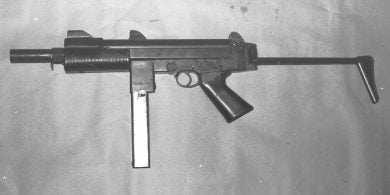
The No.1 M979 prototype shown with its simple metal stock (synthetic buttplate) open. The external portion of the 215mm barrel was fitted with a perforated metal jacket.
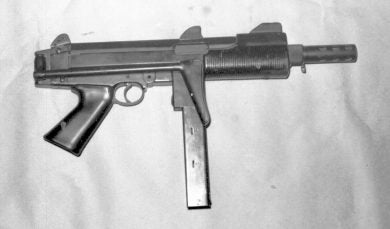
Nicknamed the “Falzinho” (Little Fal), the same gun with the stock folded to the right. Note the U-shaped cocking piece above the ejection port and the wooden handguard.
The next step, still somewhat based on the M979, was designated Sub Mtr 9 IMBEL MD1 (solid FAL stock) and Sub Mtr 9 IMBEL MD1A1 (re-shaped all-metal folding stock), incorporating some design changes here and there, but still featuring the fixed firing pin bolt. The earliest prototypes employed a machined upper receiver with a pressed steel cover on it, but follow-on examples had a single stamped receiver with 1.2mm thick walls. This resulted in an overall gun weight reduction of 300 grams to about 3.6kg, in addition to having cut down workshop work from 43 to 19 operations. The wooden handguard was reshaped in contour and received wider longitudinal grooves instead of the earlier, narrower transversal grooves. Overall length of the MD1A1 was 730mm, reduced to 495mm when the stock was folded. Although officially approved in offical tests conducted at Brazilian Army’s Campo de Provas da Marambaia (Marambaia Proving Grounds), in Rio de Janeiro, the gun was not placed in production.
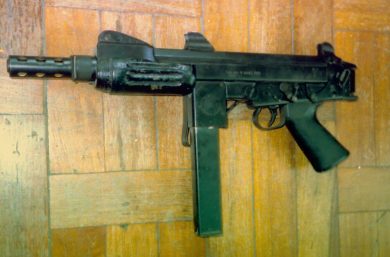
The MD1A1 with the stock folded to the right side. Like most IMBEL subgun prototypes it used 20- and 30-round staggered-row, two-position feed magazines, and employed the basic FAL pistol grip and trigger group.
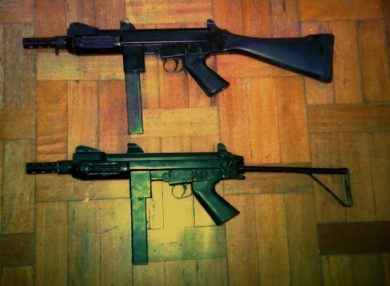
The Sub Mtr 9 IMBEL MD1 (top) and MD1A1 differed only by the type of stock fitted. Most of the later prototypes, as the ones illustrated, used a stamped upper receiver.
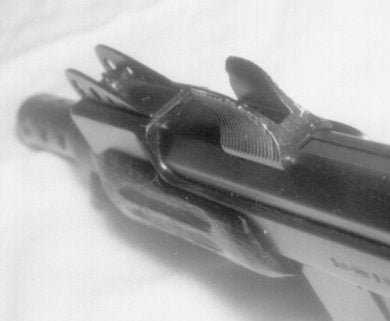
The characteristic, non-reciprocating cocking handle on top of the gun was so shaped as not to interfere with the use of the SMG’s sights.
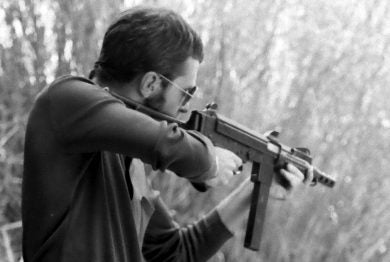
Author and an MD1A1 at IMBEL’s Fábrica de Itajubá range in the early 1980s. Gun weighed about 3.5kg and offered a cyclic rate of fire of 600 rounds-per-minute or so. It worked well enough to be approved in Brazilian Army official tests.
Since IMBEL’s primary design objective was to employ as many FAL components as possible, this was taken to a further step ahead in 1981, when the Sub Mtr 9 MD2 (solid stock) and MD2A1 (foldable metal stock) models appeared. The new prototype guns employed 90 parts common to the 7.62x51mm rifle, which translated into about 80 per cent shared components with the rifle. This included the whole machined lower receiver, firing mechanism and three-position fire selector, resulting in the guns becoming closed-breech, hammer/firing pin-fired weapons, a bonus when it came to more accurate semi-auto fire. The hard-chromed barrels (four grooves, RH rifling, 1:254mm pitch) were available in two lengths, 211mm (muzzle velocity: 400 m/s) and 160mm (360 m/s). The longer barrel was usually fitted with an external perforated sleeve and a flash hider with the same dimensions of the FAL’s, and thus allowing the fitting of… the rifle’s bayonet! Although the practical usefulness of such an item for an SMG is open to question, I was told by the IMBEL guys at the time that this had been actually required by one of the potential costumers, possibly for guard duties, so this accessory was made available. Other clearly visible FAL-related items were found, such as the protection structure for the fixed (100m) aperture rear sight and the non-reciprocating charging handle of that small variant that lies flat under spring tension when not pulled out by the operator.
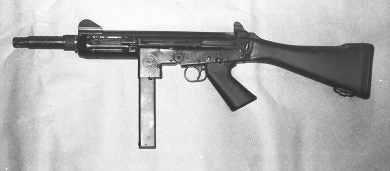
The solid-stock Sub Mtr 9 IMBEL MD2 with a 211mm barrel, displaying its clear FAL heritage. Length overall was 770mm and weight, 3.8kg.
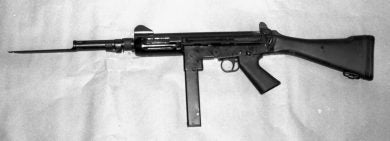
An MD2 fitted with a FAL spike (a.k.a. FN Type C) bayonet, as required by a potential client at the time. “Beware and stay back, you fools!”
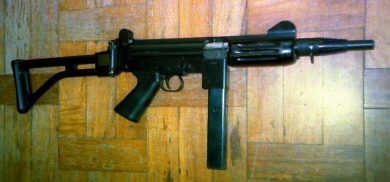
An MD2/MD2A1 prototype fitted with a PARA-FAL folding stock. Note plain (no perforated sleeve) barrel with an elongated mounting nut. Rear sight is an early FAL flip-type variant.
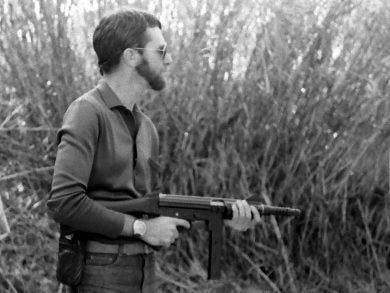
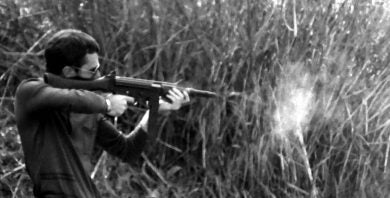
Ronaldo and the somewhat elegant (his opinion) MD2 get together at the Minas Gerais State mountains back in October, 1982. Firing from the closed-bolt position was a bonus for accuracy in the semi-auto mode.
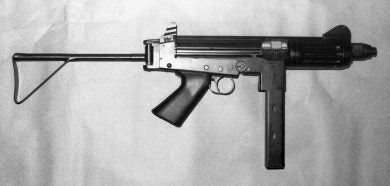
The MDA1 variant had a short (160mm) barrel that barely protruded from its mounting nut, overall length being 680m, and weight, 3.4kg. Note spring-loaded ejection port cover open and the extreme simplicity of the metal side-folding stock.
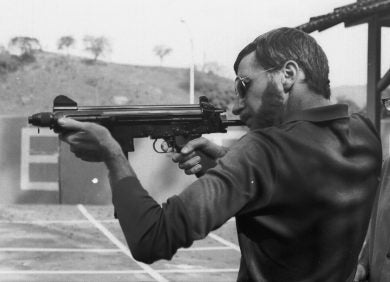
Author firing the compact MD2A1 at the Itajubá Factory range. Cyclic rate of fire was about 700 rounds per minute. Barrel was the habitual 160mm-long unit, but the 211mm variation could easily be mounted on gun if the operator so wished.
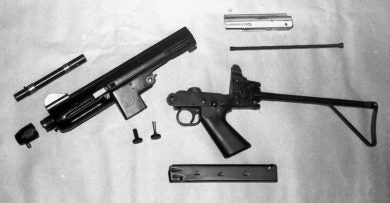
The MD2A1 field stripped, with a 30-round magazine lying beside. The staggered-row, two-position feed unit had inspection windows in the 10-, 20- and 30-rd positions.
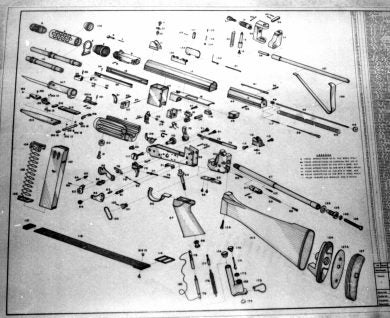
A detailed factory drawing of the Sub Mtr 9 IMBEL MD2/MD2A1 showing all component parts, including the two stock and barrel-length options.
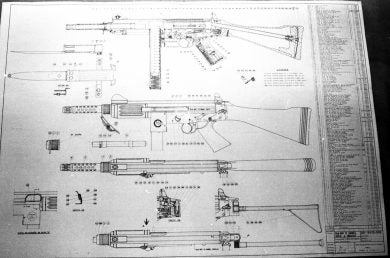
Another MD2/MD2A1 drawing shows basic differences between the two models.
A semi-automatic carbine version with a longer (401mm) barrel was also made, this being clearly intended to eventually enter the U.S. commercial market. Designated Ca 9 IMBEL MD1 (those guys loved the “MD-number” names!), it was particularly smart-looking thanks to its long perforated barrel thermal jacket and flash hider. The gun was 940mm long and weighed 3.9kg. For eventual use by law enforcement agencies using semi-auto pistol-caliber carbines, an option would be fitting the 211mm barrel of the MD2 subgun. Although the longer barrel gave a slightly higher muzzle velocity (440 m/s) than the 400 m/s offered by the SMG, it was found that the difference in terminal velocity became smaller as the range increased, mainly so when passing the 100-meter mark, a more than adequate firing distance for the caliber at hand.
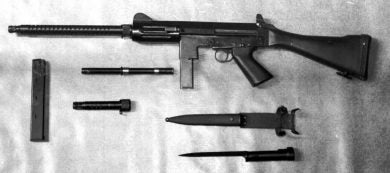
The Ca 9 IMBEL MD1 with a 401mm barrel and a 20-round magazine in place. Note optional 30-rd mag, the 211mm barrel, the shorter perforated jacket and the, eh, FAL spike bayonet.
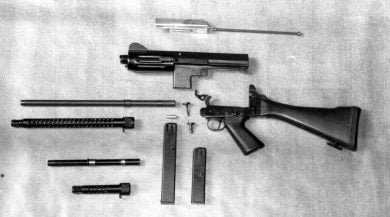
The same carbine field stripped, barrel and magazine options beside.
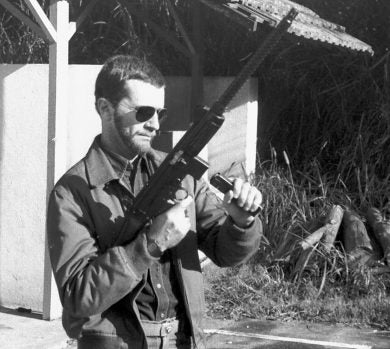
A magazine about to be inserted in the 9x19mm IMBEL carbine. Yup, Itajubá Factory range, June, 1983.
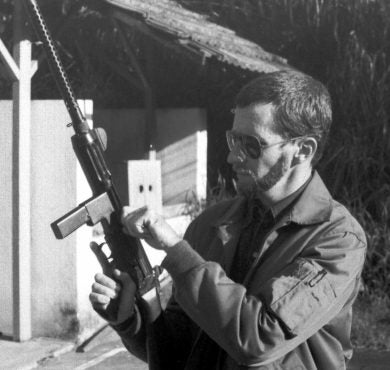
Like the previous SMG variants, the Ca 9 IMBEL MD1 was fitted with the same fold-flat charging handle found in some FALs.
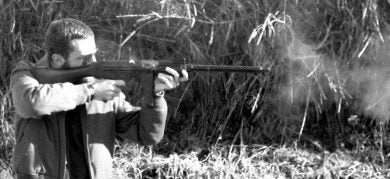
The smart carbine was a whole lot of fun to fire and very accurate within the ranges expected for a 9x19mm gun.
Well, with all these FAL-based designs having materialized into functional (fully functional, in my experience) prototypes and with installed tooling that allowed series production to be undertaken at Fábrica de Itajubá with no great efforts, one wonders what, then, happened. It seems that timing was the question. In the early 1980s, the international market was already somewhat crowded with submachine gun offerings and eventual in-country orders from the military and LE agencies (already committed to the locally-made Beretta/Taurus M12) did not seem to justify the full go-ahead for this little-publicized program carried out by a bunch of creative Brazilian designers.
I can’t help, now, but to specifically mention Brazilian Army Colonel Remy de Andrade, who headed IMBEL’s Prototypes Workshop and other top positions at Fábrica de Itajubá during the 1980s, to whom I still show my appreciation for the unrestricted support he always gave me for the preparation of articles. More often than not, he was also the guy who took most photos of yours truly with the guns!
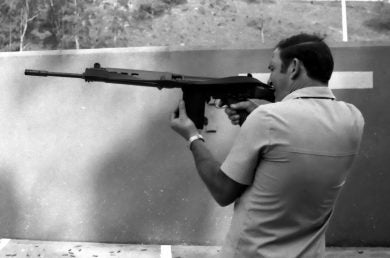
Rtd Col Remy de Andrade firing an IMBEL-made FAL (Fz 7,62 M964) at the Itajubá Factory range in the early 1980s. At long last, a public “Thank you, pal!”
 Your Privacy Choices
Your Privacy Choices
